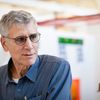Last month my institution, California College of the Arts (CCA) in San Francisco, selected scientist Amory Lovins to deliver the commencement speech and to receive an honorary doctorate. I'm sure many people in the audience were wondering why CCA, a school of the arts, chose a scientist for this honor. What could a world-renowned physicist say that would resonate with a group of artists, architects, designers, curators, and writers? Plenty, as we all found out.
Artists and Scientists: A Cultural Divide?
On the face of it, physicists and artists don't seem to have much in common. The raw materials couldn't appear to be more different. Artists often deal in imagery, metaphor, illusions, shifting perceptions, and emotions. Scientists employ numbers, equations, and data.
Our approaches also seem divergent. We, as artists and designers tend to work subjectively--we look at the universe and find ways to express what is seen and felt--to communicate an experience, something that often challenges traditional analysis and description. Working objectively, the physicist seeks to acquire new knowledge, to understand and explain the universe through inquiry based on empirical, measurable evidence, to define the principles and laws of our physical world.
One way I've heard the difference explained is that science is looking for answers and art is looking for questions. As the author James Baldwin observed, "The purpose of art is to lay bare the questions which have been hidden by the answers."
"Avatars of Human Creativity"
But if you dig a little deeper you will realize that art and science are not polar opposites. That there are far more commonalities than there are differences. Art and science are, in the words of astronaut Mae Jamison, "manifestations of the same thing. They are avatars of human creativity."
Creativity. Just one thing the disciplines share. Here are some other words that resonate for both fields: research, observation, experimentation, discovery, collaboration, and innovation.
Then why does this art-science dichotomy persist? Human history shows us that artistic and cultural upheavals have always gone hand-in-hand with scientific and technological advances.
Long-standing Connections Between Art and Science
It's easy to see the effect that science and technology have had on art and design. We have only to look around at CCA to see the amazing new tools at our disposal; 3-D printers, scanners, laser cutters, computer-controlled routers. And we must acknowledge that technological advances have profoundly altered our creative fields--animation, film, graphic design, and photography to name just a few. And CCA's newest program--Interaction Design--couldn't have existed 20 years ago.
And what about the effect of art on science? Artists, designers, and writers provide new insights and perspectives that can sow the seeds of scientific progress. Examples abound. Physicist Niels Borg was inspired by Cubism and the principle of simultaneity when seeking to understand electrons; neuroscientists study the works of Samuel Beckett (an author vitally concerned with the nature of consciousness, perception, and memory) to decipher how the brain works; and technology that was imagined in science fiction decades ago is now science fact.
As practiced today, the arts and sciences have much in common. The studio and the laboratory are learn-by-doing, learn-by-making educational experiences. The iterative process and experimentation are key components to advances and discoveries in both fields. Artists, designers, and scientists alike are utilizing data in new and interesting ways to inform their practices and affect positive change. Productive cross-disciplinary collaborations are being formed in both the academy and in the workplace.
And yet, despite the profound and long-standing connections and similarities between art and science, the cultural divide seems to prevail.
Turn STEM to STEAM
Most recently, in the wake of the recession, we have been hearing that we need to invest in STEM fields--science, technology, engineering, and math--to spur innovation and grow our economy. That seems like a very worthwhile endeavor, but it's an incomplete formula. Along with my colleague John Maeda, the president of Rhode Island School of Design, I think that we are missing a key ingredient--the arts. We need to expand the slogan, we need to turn STEM to STEAM.
To paraphrase the German theoretical physicist Max Planck, "Science can't solve everything."
Global Need for Creative People
There is a pressing need for creative people across a broad range of industries. Innovation is not the exclusive domain of scientists, programmers, and engineers. Companies and organizations that have traditionally looked to large research universities for talent are now looking for artists and designers--creative people who will bring to the workplace unique problem-solving skills, entrepreneurial spirit, and a deep understanding of the user experience.
Art school students and graduates are also having a huge impact on social innovation by bringing to light and helping to solve important global issues. Architects and designers have a unique and ethical responsibility to develop environmentally creative solutions. And artists play an increasingly significant role in addressing societal challenges as many shift toward work that is collaborative and community-based.
We need artists, architects, designers, curators, and writers to find new ways to see, feel, and create meaning in our world.
We need art school graduates to take what they've learned to work across disciplines, across diverse strands of society, across this fictional science-art cultural divide to help solve some of the world's thorniest problems.
We need creative people to form productive collaborations with scientists, educators, and technologists to make a positive impact on the world.
We need artists to keep asking the questions.
